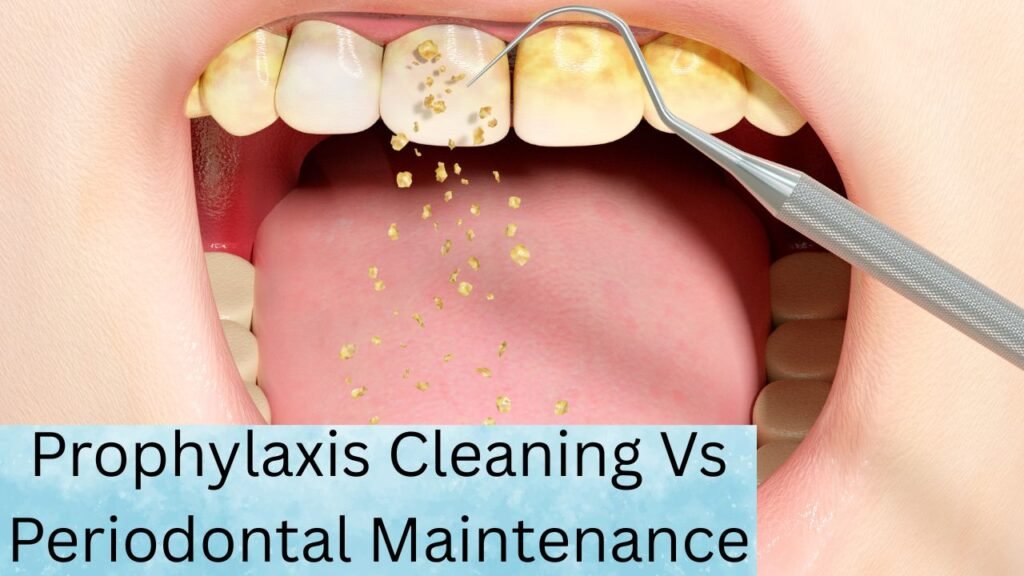Before we dive deep, here’s a quick summary table that explains what makes these two dental cleanings so different. If you’re unsure which one you need—or what your dentist meant by “deep cleaning”—this table’s your cheat sheet:
| Feature | Prophylaxis Cleaning (Regular Cleaning) | Periodontal Maintenance (Deep Cleaning Care) |
|---|---|---|
| Purpose | Prevents plaque buildup and minor gum inflammation | Maintains gum health after treatment for gum disease |
| Target Audience | Healthy patients or mild gingivitis | Individuals with history of periodontal disease |
| Cleaning Depth | Above and slightly below the gumline | Deep below the gumline into periodontal pockets |
| Frequency | Every 6 months (standard preventive schedule) | Every 3-4 months or more, depending on severity |
| Procedure Detail | Scaling, polishing, flossing | Subgingival scaling, root planing, possible antimicrobials |
| Typical Tools Used | Hand scalers, ultrasonic scaler, polishing cup | Curettes, ultrasonic scaler w/ special tips, antimicrobial gel |
🤔 What’s the Real Difference Between These Two Types of Cleanings?
Many patients in the U.S. wonder, “Why did my dentist say I need a special cleaning now?” You’ve probably been getting regular cleanings all your life, then suddenly you’re told you need “periodontal maintenance.” Let’s break that down.

Prophylaxis Cleaning: What It Really Means
This is your typical dental cleaning. The kind you get twice a year if your gums are healthy. Dentists use ultrasonic scalers and hand instruments to remove plaque and tartar from the tooth surfaces and slightly below the gumline. After that, a polishing paste is applied using a rotary brush to remove surface stains and smooth your teeth.
It’s simple, non-invasive, and keeps issues like cavities and gingivitis away.
Periodontal Maintenance: The Next Step After Gum Disease
This is not a regular cleaning. It’s part of a long-term treatment plan for people who have had gum disease—like periodontitis. After undergoing scaling and root planing (the actual deep cleaning), your gums need ongoing care to prevent bacteria from coming back and destroying the supporting bone.
During these appointments, your dental hygienist will:
- Clean deep into periodontal pockets
- Use specialized curettes and ultrasonic tips
- Sometimes apply localized antimicrobials to stop infection
- Monitor gum pocket depths and inflammation
It’s targeted. It’s therapeutic. And it’s necessary if you want to avoid tooth loss due to untreated periodontal disease.
👥 Who Needs Which Type of Cleaning?
Here’s how to know which treatment you’re a candidate for:
You Probably Need Prophylaxis If:
- You have healthy gums (no bone loss or deep pockets)
- Your pocket depths are consistently less than 4mm
- There’s no bleeding when your gums are probed
- No signs of gum recession or loose teeth
- Your X-rays show stable bone levels
You Likely Need Periodontal Maintenance If:
- You’ve been diagnosed with periodontitis
- You already had a deep cleaning (SRP) in the past
- Your pocket depths are 4mm or greater
- There’s bleeding on probing or signs of bone loss on X-rays
- You experience symptoms like bad breath, gum sensitivity, or loose teeth
🛠️ What’s Actually Involved in Each Procedure?
Let’s talk tools and steps. This is where the real difference lies.
🧼 Prophylaxis Cleaning (Standard Dental Cleaning)
- Step 1: Ultrasonic scaler breaks apart hardened tartar
- Step 2: Hand scalers remove remaining plaque
- Step 3: Flossing and checking for any early gum irritation
- Step 4: Polishing paste with a rotating rubber cup leaves your teeth smooth and shiny
Goal: A clean mouth that’s easier to maintain with daily brushing and flossing.
🧪 Periodontal Maintenance (Deep Cleaning Aftercare)
- Step 1: Subgingival cleaning—removing debris from deep pockets
- Step 2: Root planing—smoothing root surfaces to prevent bacteria buildup
- Step 3: Application of antimicrobial gels if needed
- Step 4: Detailed probing to monitor gum pocket depths
- Step 5: Evaluation of your overall periodontal stability
Goal: Stop gum disease from progressing and help gums reattach to tooth roots.
📆 How Often Should You Get These Cleanings?
Frequency matters more than most people think.
🗓️ Prophylaxis: Every 6 Months
Why? Because plaque can harden into tartar in just 48 hours. And brushing and flossing alone can’t remove tartar. Twice-yearly cleanings keep your mouth in check before small problems become big ones.
🗓️ Periodontal Maintenance: Every 3-4 Months
After gum disease treatment, your mouth needs close monitoring. Bacteria in deep gum pockets repopulate quickly—within 90 days. That’s why 3- to 4-month intervals are usually recommended to prevent relapse and maintain gum health.
💸 What About Cost and Insurance?
Let’s be real—cost matters when choosing treatments.
Insurance Coverage
- Prophylaxis: Often covered 100% under most dental plans twice a year
- Periodontal Maintenance: Typically covered at 80%, but often requires prior deep cleaning (SRP) on record
Cost Without Insurance
- Prophylaxis: Around $75–$150 per visit
- Periodontal Maintenance: Can range from $150–$300+, depending on severity and time involved
If you’re unsure what your insurance covers, ask your dental office to check procedure codes. Prophylaxis is usually coded as D1110, while periodontal maintenance is D4910.
🔍 What Happens if You Choose the Wrong Type of Cleaning?
Ignoring proper treatment can lead to:
- Advanced bone loss
- Gum recession
- Loose or shifting teeth
- Persistent bad breath
- Increased risk of systemic issues like heart disease
Think of it this way: choosing the wrong cleaning is like skipping oil changes for a car that already has engine issues. It doesn’t end well.
conclusion:
Whether you’re in a New York dental clinic or a small-town office in Kansas, your dentist isn’t trying to upsell you. Periodontal maintenance isn’t a “fancier” cleaning—it’s a medically necessary treatment for a chronic condition.
And if you’re still in the safe zone with prophylaxis? Great! Keep up the good work with your home care routine and regular visits.
But if you’ve been diagnosed with gum disease, stick with the maintenance schedule. It’s the best defense against future tooth loss.